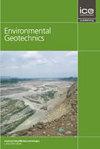垃圾填埋场底衬GGBS混合物的工程性能评估
IF 2.2
4区 工程技术
Q3 ENGINEERING, GEOLOGICAL
引用次数: 1
摘要
本工作研究了磨细高炉矿渣(GGBS)与红土-膨润土混合物混合作为底部垃圾填埋衬垫的工程特性和渗滤液特性。在本研究中,红土被称为非膨胀和非塑性粘土;相反,膨润土是高膨胀性和高塑性的粘土。进行了实验室实验,以量化GGBS红土-膨润土混合物对液限(LL)、自由膨胀指数(FSI)、压实特性、无侧限抗压强度(UCS)、导水率(k)和渗滤液测试的影响。随着混合料中GGBS百分比的增加,用去离子水/柴油污染物和渗滤液浓度测定的LL、FSI、最佳含水量k降低,而最大干密度和UCS值增加。此外,对UCS样品进行了X射线衍射分析和能量色散X射线光谱仪,以确定混合物在0、14和28天固化期内发生水化反应的证据。试验结果表明,在固化期间,Ca:Si比的增加和Al:Ca比的降低增强了UCS的增强。因此,20%的GGBS与红土土-膨润土混合物相结合,被证明是垃圾控制系统中垃圾填埋底衬的理想材料。本文章由计算机程序翻译,如有差异,请以英文原文为准。
Assessment of engineering properties on GGBS mixtures as a bottom liner in landfills
This work examines the study of engineering properties and leachate characteristics of ground granulated blast furnace slag (GGBS) blended with laterite soil-bentonite mixtures as a bottom landfill liner. In this study, laterite soil is referred to as non-expansive and non-plastic clay; on the contrary bentonite is highly expansive and high plastic clay. Laboratory experiments were performed to quantify the effect of GGBS-laterite soil-bentonite mixtures on the liquid limit (LL), free swell index (FSI), compaction characteristics, unconfined compressive strength (UCS), hydraulic conductivity (k), and leachate tests. As GGBS percentage in the mix blend increases, the LL, FSI, optimum moisture content, k determined with deionized water/diesel oil contaminants and leachate concentration decreases, whereas maximum dry densities and UCS value increases. Furthermore, X-ray diffraction analysis and energy dispersive X-ray spectrometer was performed on UCS samples to determine the evidence of hydration reaction in mix blends at 0, 14, and 28 days curing period. The test results revealed that an increase in Ca: Si ratio and a decrease in Al: Ca ratios, augmented the UCS enhancement during the curing period. Consequently, 20% GGBS combined with laterite soil-bentonite mixes proves to be the ideal material for landfill bottom liners in waste containment systems.
求助全文
通过发布文献求助,成功后即可免费获取论文全文。
去求助
来源期刊

Environmental geotechnics
Environmental Science-Water Science and Technology
CiteScore
6.20
自引率
18.20%
发文量
53
期刊介绍:
In 21st century living, engineers and researchers need to deal with growing problems related to climate change, oil and water storage, handling, storage and disposal of toxic and hazardous wastes, remediation of contaminated sites, sustainable development and energy derived from the ground.
Environmental Geotechnics aims to disseminate knowledge and provides a fresh perspective regarding the basic concepts, theory, techniques and field applicability of innovative testing and analysis methodologies and engineering practices in geoenvironmental engineering.
The journal''s Editor in Chief is a Member of the Committee on Publication Ethics.
All relevant papers are carefully considered, vetted by a distinguished team of international experts and rapidly published. Full research papers, short communications and comprehensive review articles are published under the following broad subject categories:
geochemistry and geohydrology,
soil and rock physics, biological processes in soil, soil-atmosphere interaction,
electrical, electromagnetic and thermal characteristics of porous media,
waste management, utilization of wastes, multiphase science, landslide wasting,
soil and water conservation,
sensor development and applications,
the impact of climatic changes on geoenvironmental, geothermal/ground-source energy, carbon sequestration, oil and gas extraction techniques,
uncertainty, reliability and risk, monitoring and forensic geotechnics.
 求助内容:
求助内容: 应助结果提醒方式:
应助结果提醒方式:


